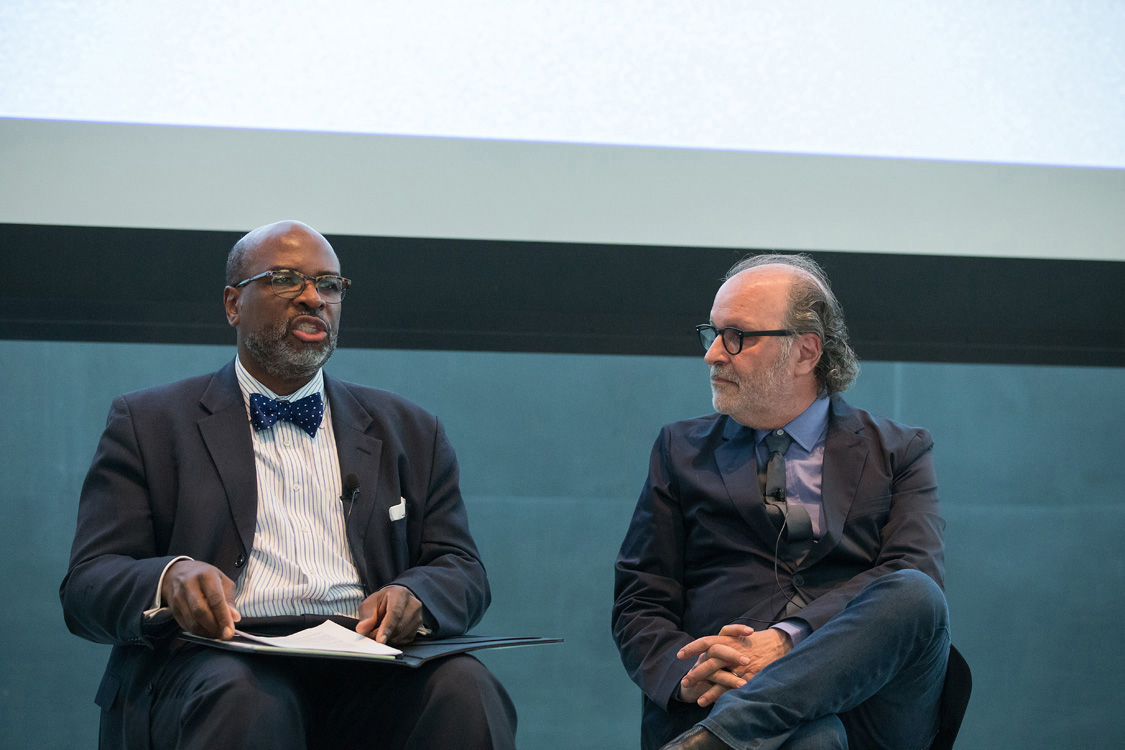Clarke, Brann explore 'Blacks and Jews in America'
By Kathy Hovis

The relationship between blacks and Jews in America isn’t always an easy topic to discuss, but it’s the obligation of universities like Cornell to open up conversations on challenging topics like this, said Gretchen Ritter, the Harold Tanner Dean of the College of Arts and Sciences as she introduced the “Blacks and Jews in America” event April 18 on campus.
Kenneth Clarke, director of Cornell United Religious Work, and Ross Brann, the Milton R. Konvitz Professor of Judeo-Islamic Studies in the Department of Near Eastern Studies, shared their perspectives on the history of relations between the two groups and challenged audience members to consider what might be next.
Throughout the 20th century, the relationship has been alternately rocky and close-knit, they said.
Jews and Blacks had a shared history of discrimination in the U.S. throughout the early part of the century, Brann said, though Jews were not forced to come to America as slaves.
The early 1900s were years of frequent lynchings of blacks and widespread discrimination, Clarke said, but African-Americans soon banded together under leaders like W.E.B. DuBois and demanding action through groups like the Niagara movement, a precursor to the NAACP.
Jewish immigrants arrived in waves from the late 1800s through the 1920s and suffered widespread discrimination as well. Brann showed slides depicting verbal and physical attacks on Jews and barriers to keep them from fully integrating into society. At Cornell, in a 1947 poll, 43 percent of students said they would not room with a Jewish student, while only 33 percent said they would refuse to room with a black student.
Jewish college students found alliance with black students – though there were few black students on campus at this time, Brann said – and Jewish leaders like Rabbi Mordecai Kaplan challenged Jews to become champions for all oppressed people. In the 1960s, Jews played key roles in the civil rights movement, with Jewish students making up more than half of the freedom riders, Brann said.
Along with these youth-oriented movements, coalitions like those between Dr. Martin Luther King Jr. and Rabbi Abraham Joshua Heschel formed.
“Their friendship symbolized how the desire for civil rights was transformed into a human rights struggle that expanded to include educational equality, fair housing and anti-war activities,” Clarke said. Yet despite all of the struggles the groups had in common, multiple factors led to the unraveling of that coalition in the late 1960s, he said.
“The social upheaval and identity politics that took over the entire country, and especially college campuses, changed the relationship forever,” Brann said. Clarke pointed to two factors in particular: some leaders of the black power movement were reconsidering the role of whites in their groups, and the 1967 Six-Day War shifted the focus of many American Jews away from civil rights and toward support for Israel.
Students Eliana Jacobson ’16 and Emeka Ikpeazu ’16 said they came to the event curious to learn more about the topic.
Ikpeazu, an electrical and computer engineering major, said he wondered why anti-Semitism seems to be a popular rallying point for seemingly disparate groups like the Ku Klux Klan and the Nation of Islam, as Clarke and Brann described.
Jacobson, an environmental science and sustainability major in the College of Agriculture and Life Sciences, said she’s been intrigued by the discussions around these issues in her government class “Obama and the Meaning of Race.”
“I’ve had talks with my grandmother, who grew up in Baltimore, and she’s disappointed about where we are with race relations in this country,” Jacobson said. “She thought we’d be a lot further along by this time.”
Brann and Clarke say there have been moments of cooperation and shared movements since the fallout of the 1960s, citing groups like Jews for Racial and Economic Justice, campus initiatives like Cornell’s “Breaking Bread” dinners and a diverse group of activists involved in the Black Lives Matter movement.
“Because of globalization, I see some things happening that lead me to believe we may be on the cusp of a transformational moment,” Brann said. “Young people at Cornell are willing to open themselves up to other people’s experiences, which could lead to a rekindling of empathy and rebirth of coalition the likes of which I haven’t seen since I was in college.”
But Clarke said this year’s presidential campaign has been disheartening, at least in terms of what’s been covered by mainstream media, which has focused on vitriol from certain candidates rather than grassroots movements.
Kathy Hovis is a writer for the College of Arts and Sciences.
Media Contact
Get Cornell news delivered right to your inbox.
Subscribe